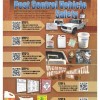 Do you need to train your employees about vehicle safety while transporting pesticides? This poster introduces safety concepts when transporting pesticides on a vehicle and alerts new pest control technicians to the pest control vehicle regulations of the Florida Department of Agriculture. The poster has quick response (QR) codes linked to short, online videos that take the technicians though six steps of maintaining a safe and legal service vehicle. This poster will serve as a valuable training and refresher tool. Designed by R.W. Baldwin, S.K. Hill, Philip Koehler, P.A. Mitola, and J.C. Medley, and published by the UF Department of Entomology and Nematology, August 2012.
Do you need to train your employees about vehicle safety while transporting pesticides? This poster introduces safety concepts when transporting pesticides on a vehicle and alerts new pest control technicians to the pest control vehicle regulations of the Florida Department of Agriculture. The poster has quick response (QR) codes linked to short, online videos that take the technicians though six steps of maintaining a safe and legal service vehicle. This poster will serve as a valuable training and refresher tool. Designed by R.W. Baldwin, S.K. Hill, Philip Koehler, P.A. Mitola, and J.C. Medley, and published by the UF Department of Entomology and Nematology, August 2012.
http://edis.ifas.ufl.edu/in963
Tag: Pesticide Safety Miniposter series
Pesticide Safety Miniposter: Pesticide Spill Control (ENY2011/IN961)
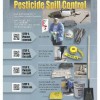 This poster acquaints new pest control technicians with proper procedures to manage an unscheduled pesticide release. The poster has quick response (QR) codes that direct a smartphone to online videos highlighting the steps of cleaning up a pesticide spill site, beginning with controlling the spill and ending with decontamination of the site. This poster will serve as a valuable training tool for new technicians and a refresher tool for pesticide applicators. Designed by R.W. Baldwin, S.K. Hill, Philip Koehler, P.A. Mitola, and J.C. Medley, and published by the UF Department of Entomology and Nematology, August 2012.
This poster acquaints new pest control technicians with proper procedures to manage an unscheduled pesticide release. The poster has quick response (QR) codes that direct a smartphone to online videos highlighting the steps of cleaning up a pesticide spill site, beginning with controlling the spill and ending with decontamination of the site. This poster will serve as a valuable training tool for new technicians and a refresher tool for pesticide applicators. Designed by R.W. Baldwin, S.K. Hill, Philip Koehler, P.A. Mitola, and J.C. Medley, and published by the UF Department of Entomology and Nematology, August 2012.
http://edis.ifas.ufl.edu/in961
Pesticide Safety Miniposter: Triple Rinse Steps (ENY2012/IN962)
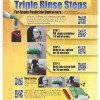 The Triple Rinse poster acquaints new pest management technicians to proper techniques to clean and dispose of empty pesticide containers. The poster uses quick response (QR) codes that direct smartphones to online videos that demonstrate the triple rinse process and container disposal. This poster will serve as a valuable training tool for new technicians and a refresher tool for pesticide applicators. Designed by R.W. Baldwin, S.K. Hill, Philip Koehler, W. Walker, and J.C. Medley, and published by the UF Department of Entomology and Nematology, 8. http://edis.ifas.ufl.edu/in962
The Triple Rinse poster acquaints new pest management technicians to proper techniques to clean and dispose of empty pesticide containers. The poster uses quick response (QR) codes that direct smartphones to online videos that demonstrate the triple rinse process and container disposal. This poster will serve as a valuable training tool for new technicians and a refresher tool for pesticide applicators. Designed by R.W. Baldwin, S.K. Hill, Philip Koehler, W. Walker, and J.C. Medley, and published by the UF Department of Entomology and Nematology, 8. http://edis.ifas.ufl.edu/in962
Pesticide Safety Miniposter: Pesticide Emergencies (ENY916/IN954)
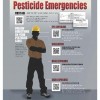 This poster introduces new pest control technicians to the general actions to be taken in the event of pesticide exposure. Technicians learn to recognize symptoms of exposure as they watch videos linked to the quick response (QR) codes on the poster. The videos detail general first aid steps to undertake until medical help arrives after a pesticide exposure. Designed by R.W. Baldwin, S.K. Hill, Philip Koehler, W. Walker, and J.C. Medley, and published by the UF Department of Entomology and Nematology, August 2012.
This poster introduces new pest control technicians to the general actions to be taken in the event of pesticide exposure. Technicians learn to recognize symptoms of exposure as they watch videos linked to the quick response (QR) codes on the poster. The videos detail general first aid steps to undertake until medical help arrives after a pesticide exposure. Designed by R.W. Baldwin, S.K. Hill, Philip Koehler, W. Walker, and J.C. Medley, and published by the UF Department of Entomology and Nematology, August 2012.
http://edis.ifas.ufl.edu/in954
Pesticide Safety Miniposter: Pesticide Formulations (ENY915/IN955)
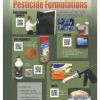 Do you need a quick training reference to common pesticide formulations? This poster introduces new pest control technicians to pesticide product formulations. The poster has quick response (QR) codes that link to videos showing example formulations of liquid pesticides, baits, pressurized aerosols, and a variety of dry product pesticides. Technicians need to be familiar with the products and formulations they are using, so this poster and its videos will be a useful training tool for pest management companies. Designed by R.W. Baldwin, S.K. Hill, Philip Koehler, P.A. Mitola, and J.C. Medley, and published by the UF Department of Entomology and Nematology, August 2012.
Do you need a quick training reference to common pesticide formulations? This poster introduces new pest control technicians to pesticide product formulations. The poster has quick response (QR) codes that link to videos showing example formulations of liquid pesticides, baits, pressurized aerosols, and a variety of dry product pesticides. Technicians need to be familiar with the products and formulations they are using, so this poster and its videos will be a useful training tool for pest management companies. Designed by R.W. Baldwin, S.K. Hill, Philip Koehler, P.A. Mitola, and J.C. Medley, and published by the UF Department of Entomology and Nematology, August 2012.
http://edis.ifas.ufl.edu/in955
Pesticide Safety Miniposter: Daily Personal Care (ENY917/IN956)
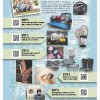 Anyone applying pesticides should be aware of the importance of preventing pesticide exposure to themselves, their families, and their pets by following a few personal care procedures each day. The information and video links (QR codes) on the Daily Personal Care poster provide technicians with examples of areas that are commonly contaminated by pesticides. The poster explains methods for the decontamination of vehicles, application equipment, personal items like cell phones, and clothing. Designed by R.W. Baldwin, S.K. Hill, Philip Koehler, W. Walker, and J.C. Medley, and published by the UF Department of Entomology and Nematology, August 2012.
Anyone applying pesticides should be aware of the importance of preventing pesticide exposure to themselves, their families, and their pets by following a few personal care procedures each day. The information and video links (QR codes) on the Daily Personal Care poster provide technicians with examples of areas that are commonly contaminated by pesticides. The poster explains methods for the decontamination of vehicles, application equipment, personal items like cell phones, and clothing. Designed by R.W. Baldwin, S.K. Hill, Philip Koehler, W. Walker, and J.C. Medley, and published by the UF Department of Entomology and Nematology, August 2012.
http://edis.ifas.ufl.edu/in956
Pesticide Safety Miniposter: Labels and Material Safety Data Sheets (MSDSs) (ENY918/IN958)
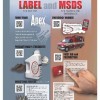 You have heard the phrase, “the label is the law.” Pest control technicians need to learn the components of a pesticide label and the information they can find on the Material Safety Data Sheet (MSDS). This poster acquaints new pest control technicians with the information they will find on pesticide labels and on MSDSs. The poster has quick response (QR) codes that direct smartphones to short, online videos explaining how to read pesticide labels and MSDSs. Designed by R.W. Baldwin, S.K. Hill, Philip Koehler, P.A. Mitola, and J.C. Medley, and published by the UF Department of Entomology and Nematology, August 2012.
You have heard the phrase, “the label is the law.” Pest control technicians need to learn the components of a pesticide label and the information they can find on the Material Safety Data Sheet (MSDS). This poster acquaints new pest control technicians with the information they will find on pesticide labels and on MSDSs. The poster has quick response (QR) codes that direct smartphones to short, online videos explaining how to read pesticide labels and MSDSs. Designed by R.W. Baldwin, S.K. Hill, Philip Koehler, P.A. Mitola, and J.C. Medley, and published by the UF Department of Entomology and Nematology, August 2012.
http://edis.ifas.ufl.edu/in958
Pesticide Safety Miniposter: Apply the Correct Amount (ENY919/IN959)
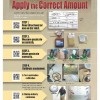 Pest managers must know the proper amount of pesticide product to apply. This poster acquaints new pest control technicians with the basic process of following label instructions to properly dilute pesticides, and it walks technicians through two types of basic equipment calibration. The poster has quick response (QR) codes that link smartphones to online videos illustrating each step in applying the correct amount of pesticides. Designed by R.W. Baldwin, S.K. Hill, Philip Koehler, W. Walker, and J.C. Medley, and published by the UF Department of Entomology and Nematology, August 2012.
Pest managers must know the proper amount of pesticide product to apply. This poster acquaints new pest control technicians with the basic process of following label instructions to properly dilute pesticides, and it walks technicians through two types of basic equipment calibration. The poster has quick response (QR) codes that link smartphones to online videos illustrating each step in applying the correct amount of pesticides. Designed by R.W. Baldwin, S.K. Hill, Philip Koehler, W. Walker, and J.C. Medley, and published by the UF Department of Entomology and Nematology, August 2012.
http://edis.ifas.ufl.edu/in959
Pesticide Safety Miniposter: Protecting Yourself (ENY2010/IN960)
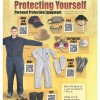 To properly apply pesticides, a technician must be aware of the personal protective equipment, or PPE, required for the application. This poster introduces new pest control technicians to different types of PPE they may be required to wear during a pesticide application or pest management inspection. There is a wide array of examples of PPE on the poster, with quick response (QR) codes that direct smartphones to short, online videos explaining PPE for each area of the body (head, eyes, face, mouth, hands and arms, torso and feet). This poster will serve as a valuable training tool for new technicians and a refresher tool for pest managers. Designed by R.W. Baldwin, S.K. Hill, Philip Koehler, W. Walker, and J.C. Medley, and published by the UF Department of Entomology and Nematology, August 2012.
To properly apply pesticides, a technician must be aware of the personal protective equipment, or PPE, required for the application. This poster introduces new pest control technicians to different types of PPE they may be required to wear during a pesticide application or pest management inspection. There is a wide array of examples of PPE on the poster, with quick response (QR) codes that direct smartphones to short, online videos explaining PPE for each area of the body (head, eyes, face, mouth, hands and arms, torso and feet). This poster will serve as a valuable training tool for new technicians and a refresher tool for pest managers. Designed by R.W. Baldwin, S.K. Hill, Philip Koehler, W. Walker, and J.C. Medley, and published by the UF Department of Entomology and Nematology, August 2012.
http://edis.ifas.ufl.edu/in960